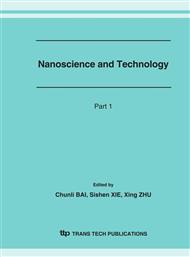p.665
p.669
p.673
p.677
p.681
p.685
p.689
p.693
p.697
Nano Sized Patterning on the Thermoset Materials Using Thermal Curing Nano-Imprinting Technology
Abstract:
Nano-imprinting technology, currently developing as an alternative technology for photolithography, is mostly dealing with photo resist materials for etching barrier. In other words, the materials imprinted are used as the barriers for wet etching or RIE (reactive ion etching), and then are removed after all. Thus, most materials developed for nano-imprinting technology have relatively low Tg(<100oC), in case of solids or have a low viscosity before curing in order to fill the gap of the stamp. Such materials could not be suitable for the structures that require relatively high temperature process ability, high modulus or high durability. Epoxy is one of candidates that meet such requirements for the structures. However, it has not been reported about imprinting on epoxy materials. In this paper, nano-imprinting technology was developed to fabricate the microstructures. Instead of thermoplastic imprint resin, solid phase epoxy films, which is thermoset polymer, were imprinted with SAM (self assembly monolayer) coated quartz and silicon stamps. Feature size of stamp varies from 150nm to 1 μm and height was 300nm for quartz stamp and 3μm for Si stamp.
Info:
Periodical:
Pages:
681-684
Citation:
Online since:
March 2007
Authors:
Price:
Сopyright:
© 2007 Trans Tech Publications Ltd. All Rights Reserved
Share:
Citation:


